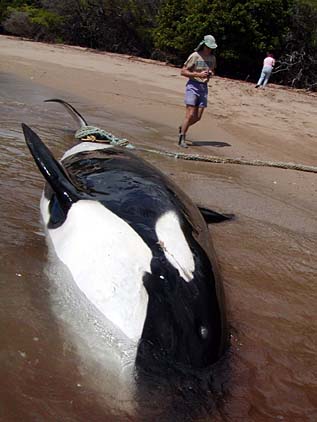
COURTESY OF THE NATIONAL OCEANIC AND ATMOSPHERIC ADMINISTRATION
Scientists from the National Oceanic and Atmospheric Administration examine the body of an orca that was found dead Tuesday off the southeast coast of Lanai. The cause of the animal's death has not yet been determined.
Death of killer whale
off Lanai is a mysteryTissue samples sent to a lab
could reveal if it was diseased
A whale rarely seen in Hawaiian waters was found dead Tuesday in shallow surf off the southeast coast of Lanai.
The 4,000-pound, adult female orca -- or killer whale -- was spotted Tuesday afternoon by scientists off the coast who were conducting research on humpback whales.
They said the whale appeared to be alive but stranded in waters that were about 3 feet deep.
A National Oceanic and Atmospheric Administration team was at the site within an hour.
By that time, though, the orca was already dead.
A necropsy of the animal found no cause of death. Its remains were buried on Lanai.
The orca's age had not been determined yesterday. Killer whales can live to be 50 to 80 years old.
NOAA spokeswoman Delores Clark said tissue samples sent to the Armed Forces Institute of Pathology in California could provide more information on whether the animal was suffering from a disease.
Orcas prefer colder water, and only about one is seen in waters off the islands annually, Clark said.
The killer whales are protected under the Marine Mammal Protection Act but not listed as threatened or endangered under the Endangered Species Act.
"It's uncommon to see the whales here," Clark said.
Clark said the dead animal was one of two orcas reported off the coast of Lanai Tuesday.
The scientists who saw the stranded whale also spotted another orca nearby, she said. NOAA researchers were not able to find the healthy orca.
Brad Ryon, of NOAA, said in a statement that Lanai residents helped bury the whale and offered equipment and transportation to agency personnel.
"Some of them even brought their kids," Ryon said, "and turned the experience into an educational event."
While researchers worked with the whale's corpse on the Lanai shore, the Federal Aviation Administration instituted a no-fly zone to guard against "aerial harassment," Ryon said.
— ADVERTISEMENTS —
— ADVERTISEMENTS —
